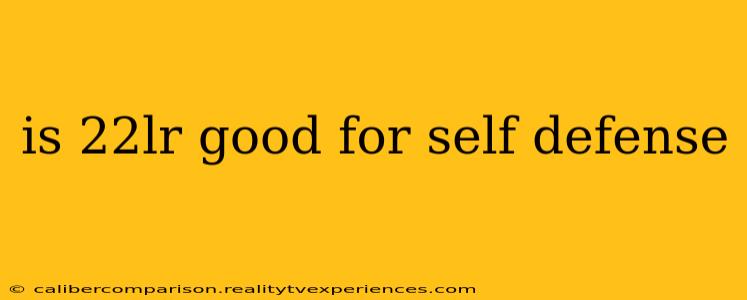Is .22 LR Good for Self-Defense? A Comprehensive Look at the Caliber's Strengths and Weaknesses
The question of whether .22 Long Rifle (.22 LR) is suitable for self-defense is complex and sparks considerable debate among firearms enthusiasts and experts. There's no simple yes or no answer; the effectiveness of any caliber depends heavily on various factors, including shot placement, the user's training, and the specific circumstances of a self-defense situation.
This article delves into the strengths and weaknesses of .22 LR for self-defense, providing a balanced perspective to help you make an informed decision.
Advantages of .22 LR for Self-Defense
-
High Capacity: .22 LR firearms often boast significantly higher magazine capacities than larger calibers. This translates to more shots available in a self-defense scenario, potentially offering a crucial advantage if multiple attackers are involved. This is particularly relevant for those who prioritize firepower in a high-threat environment.
-
Easy to Shoot and Control: The low recoil of .22 LR makes it relatively easy to shoot accurately, even for individuals with less experience. This is a significant advantage in a stressful self-defense situation where accurate shot placement is paramount. Reduced recoil can also lead to faster follow-up shots.
-
Lower Cost and Accessibility: .22 LR ammunition is generally less expensive than other calibers, making it more affordable to practice regularly. Consistent practice is crucial for proficiency in any self-defense scenario. Furthermore, .22 LR firearms tend to be more affordable, making them accessible to a wider range of individuals.
-
Quieter than Larger Calibers: The .22 LR's relatively quiet report can be advantageous in close-quarters situations, minimizing the risk of alerting unwanted attention or escalating the situation unnecessarily.
Disadvantages of .22 LR for Self-Defense
-
Limited Stopping Power: This is arguably the most significant drawback. .22 LR cartridges generally lack the stopping power of larger calibers, meaning they may not immediately incapacitate an attacker. While penetration can vary depending on the ammunition, its energy transfer is significantly lower.
-
Increased Shot Placement Requirement: Due to the lower stopping power, extremely precise shot placement is critical for effectiveness. A miss or a poorly placed shot will significantly reduce the likelihood of stopping a threat. This places a high demand on the user's marksmanship skills.
-
Potential for Overpenetration in Certain Situations: While generally not known for extreme overpenetration, using .22 LR in close quarters or through barriers can lead to unexpected ricochets or penetration beyond the intended target, posing a risk to bystanders.
-
Reliance on Multiple Hits: Successfully neutralizing a threat often requires multiple well-placed shots, emphasizing the critical need for proficient marksmanship and training.
Conclusion: Is .22 LR Right for You?
The suitability of .22 LR for self-defense ultimately depends on individual circumstances, training, and risk assessment. While it offers advantages in terms of capacity, cost, and ease of use, its limited stopping power should not be overlooked. Individuals choosing .22 LR for self-defense must be acutely aware of its limitations and possess a high level of marksmanship proficiency to compensate for its shortcomings. It's crucial to prioritize proper training and understand the ethical and legal implications of using any firearm for self-defense. Consulting with firearms experts and law enforcement professionals is strongly recommended before making a decision. This information is for educational purposes only and should not be considered professional advice. Always follow all local and federal laws regarding firearms ownership and use.

